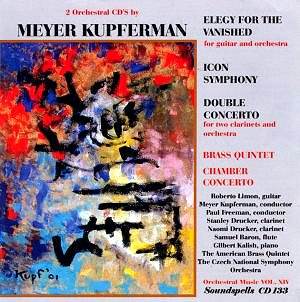This is the first of two 2CD volumes of the orchestral
music of Meyer Kupferman.
The prodigiously productive Meyer Kupferman wrote
a four minute solo guitar piece in memory of Rosanna Limón,
the murdered sister of the guitarist Roberto Limón. That
was in 1997. His Elegy for the Vanished is a full-blown
development of that piece. The composer speaks of the piece as
a 'gestalt form' - a fantasy concerto with classical, romantic,
Iberian and avant-garde gestures in the mix. This piece is of
symphonic proportions and the performance here has the added authority
of the composer conducting and the dedicatee and brother of Rosanna
playing the guitar. Kupferman's generously stocked imagination
sings in full flood in this work and contrasts with the unyielding
ultra-modernities of the Quantum Symphony and Foxfire
piano concerto. Here the slightly melancholy caste of the
music links with that British arch-romantic Arnold Bax and with
Robert Starer's Viola Concerto but with a fine sheen of dissonance.
This is a gloriously impressionistic and emotional work in which
invention is convincingly sustained across the 36 minute duration.
This can be grouped with the better guitar works of Rodrigo (Aranjuez
and Andaluz), Ponce, Arnold, Walton and Sylvie Bodorová
(the latter superbly recorded on a recent Arco Diva CD). The cover
art by Kupferman is an abstract sharing the same title as this
piece which ends in serenity. This may well be one of the undiscovered
masterworks of the last century; certainly a work in which Kupferman
speaks directly and with an authentic creative urge.
The Icon Symphony is in four brief
movements. The composer compares it to a Credo in four parts with
each tracked separately. The first rises from avant-garde ballistics
to stratospheric heights almost suggestive of Scriabin in his
Mysterium (see Ashkenazy's 'complete' recording on Decca).
The 9 minute long quasi-cadenza has more lyrical material than
the other movements connecting with the end of the first. The
final allegro barbaro is savage, perhaps reflecting images
of ignorant armies clashing by night not even redeemed by self-sacrificial
motives or anything approaching heroism. You may feel awe but
this does not reach towards any human emotions except perhaps
fear.
The Concerto for two clarinets and orchestra
was written in 1991 and revised in 2000. The revised version is
what was recorded here. It was commissioned for Stanley and Naomi
Drucker, the husband and wife team. Stanley Drucker's name is
very well known as the lead clarinet with the NYPO. The premiere
was with the Nassau Symphony conducted by Andrew Schenck. The
two movement avant-garde piece comprises a whimsical, sarcastic,
perky and humorous Molto allegro e scherzando fantastico and
a much more serious Misterioso which connects with the
clarinet's singing soul - strangely this reminded me of Nyman
and Heath (both the Linn and Black Box collections). The two movements
seem unequal bedfellows though each piece satisfies in its own
right.
The 1970 Brass Quintet is a strictly serial
piece based on Kupferman's so-called 'infinities' row. It is in
two movements. The short adagio bristles with intriguingly rasping
outbursts and hoarse skirling noises. It is given a tour de force
of an outing. The two trumpeters include Gerard Schwarz better
known now as a conductor. Schwarz was also a trumpeter in the
wind symphony orchestras' recording of Alan Hovhaness's Ani
Symphony (Crystal). This recording is taken from a Serenus Editions
LP from 1973-74 (SRS12041) and a very slight surface rustle can
be heard. Both this recording and the Chamber Concerto are ex-Serenus
tapes with the recordings taken from and with the permission of
the Music Library of the Lincoln Center.
The Chamber Concerto (for the greater
part a double concerto for flute and piano) belongs to a group
that includes the Fourth Symphony, the Lyric Symphony and
Libretto for Orchestra ; works from the mid-1950s in
large free-shaped one-movement forms. It is from Serenus LP 12304.
Kupferman regards this as one of his favourite early pieces and
one from which he drew many ideas for later works. The recording
has stunning immediacy. Free use is made of dissonance but the
lines are identifiably melodic, connected and pregnant with warm
colour and yielding expression. There is about much of this music
something of Ned Rorem's susceptibility to elysian French summers,
lost domains ... the poignant nostalgia of Alain Fournier's 'Grand
Meaulnes'; something of Poulenc and Berkeley also. The flute is
played by Samuel Baron (1925-1997). Mention of Baron's name reminds
me that his multi-tracked version of Hovhaness's The Spirit
of Ink was reviewed here not so very long ago (Crystal CD809).
Irritatingly the norm with Soundspell seems to
be to omit details of the date and location of recording sessions.
Fortunately this is not the case with volumes XIV and XV of the
Kupferman series.
The series is distinguished by Mr Kupferman's
paintings reproduced on the booklet covers.
Kupferman's wide range fully displayed from the
griping and expostulation of the Icon Symphony and Quintet
to the early lyricism of the Chamber Concerto and the late and
deeply affecting lyricism of the Elegy.
Rob Barnett
